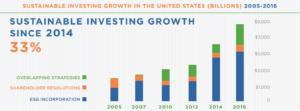
Sustainable investing isn’t just for do-gooders. In Part 1 of this two-part series, we explore the growth of sustainable investing and discuss why smart investors are getting on board.
Sustainable investing is going mainstream. It’s no longer just about 350.org campaigning for fossil fuel divestment on college campuses, or a niche group of investors willing to sacrifice financial returns in favor of social and environmental impact.
Instead, it’s about savvy investors making smart decisions on where to put their dollars, taking the whole picture of a company, fund, or bond into consideration. And there are a lot of them. In November 2016, US SIF reported that more than $8.7 trillion of U.S. investments consider environmental, social, and governance (ESG) factors, up 33 percent since 2014. This is fully one-fifth of all professionally managed assets.
This number is only expected to grow as a new generation of investors takes over. According to research from Accenture, as baby boomers pass on their wealth over the next 30 years, more than $30 trillion in financial assets will change hands in North America. This new generation of investors is different. The Morgan Stanley Institute for Sustainable Investing found that millennial investors are more than twice as likely as other generations to invest in companies and funds that target specific social and environmental outcomes.
These investors aren’t in it for #allthefeels. The evidence is clear that sustainability has significant benefits for business performance. Companies that rank highly on resource efficiency produce better financial returns and stronger margins, returns on assets, and returns on equity. Moreover, a team of researchers from Harvard Business school showed in 2015 that firms that invest in managing their material sustainability issues have higher risk-adjusted stock performance than those that are less strategic about sustainability.
The Dinosaur in the Room
So let’s go back to the fossil fuel example. A smart investor doesn’t need to take up a personal crusade against climate change to pull back on fossil fuels. She can see that in time, the industry is bound to go the way of the dinosaurs.
- Market Forces: Smart investors put their money in growth industries. Follow the jobs: the U.S. solar industry now employs more people than oil, gas, and coal combined, and saw growth of around 73,000 new jobs in 2016 alone.
- Stranded Assets: Despite the current policy debates in the U.S., the 2015 Paris Agreement signals a path forward on climate at the global level. With China and India committing to carbon reductions, any investor that expects policy changes to limit carbon emissions down the road should be concerned about stranded assets. While a few years old at this point, the logic of Carbon Tracker’s 2011 Unburnable Carbon report still stands. The oil and gas sector may be vastly over-valued based on carbon reserves that, in the face of strict emissions caps, will become unburnable.
- Governance and Transparency: The fossil fuel industry has no shortage of examples of scandal, lawsuits, and other risks. The revelations that Exxon Mobil deliberately misled the public and hid its research on climate change for nearly 40 years should be troubling to anyone who is paying attention. The company saw a risk to its own operations and swept it under the rug in the pursuit of profits. If a company can hide something that big, what else aren’t they telling investors?
With all this in mind, where would you put your money? If, like me, you hope to retire someday, you’ll make your bets outside of fossil fuels.
So how can businesses position themselves to succeed in a new era of investing? Read Part 2 of my blog – A company’s guide to sustainable investing – to see how they can make the most of this growing trend.
